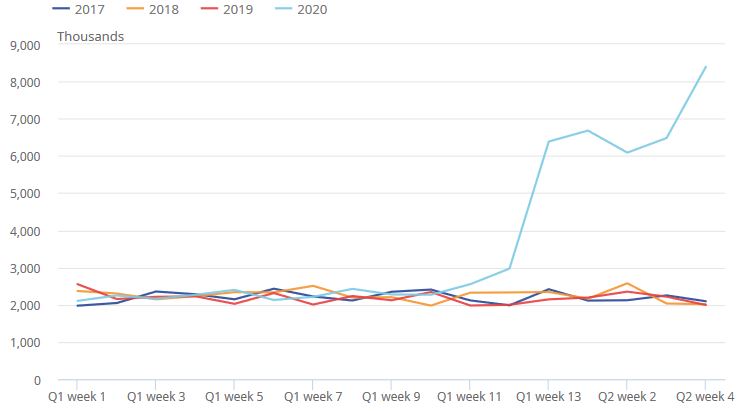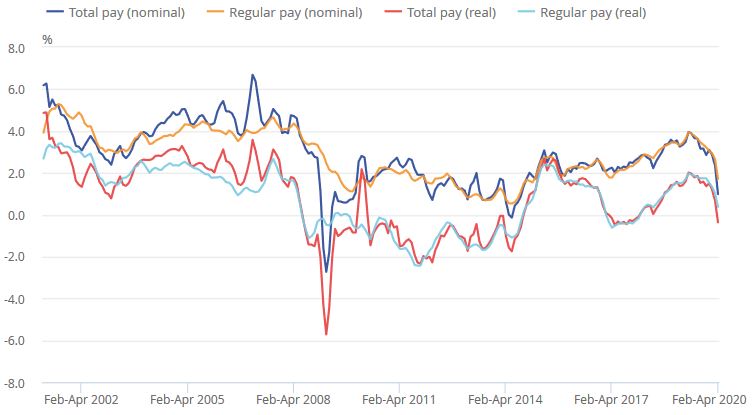ONS Labour Market Overview June 2020
The latest data from the ONS gives an indication of the impact of the coronavirus crisis on the labour market. Although the UK unemployment rate was broadly unchanged in the three months to April, early indications suggest workers on company payrolls fell by 612,000 between March and May, while job vacancies dropped to a record low in May. .
Hours worked fall at record rate
Based on flash estimates for May using PAYE data, the number of paid employees dropped by 2.1% (612,000) compared with March. Early estimates for the month suggest that median monthly pay fell by 1.8% compared with a year earlier.
The total number of weekly hours worked decreased at the highest annual rate on record. Between February and April 2020, total actual weekly hours worked in the UK decreased by 94.2 million – down 8.9% compared to last year – to 959.9 million hours. Accommodation and food services were the hardest hit – down 6.9 hours to 21.2 hours per week.
Vacancies at record low
Between March and May, the ONS recorded the largest quarterly decrease in job vacancies since records began in 2001. During the period there were an estimated 476,000 vacancies in the UK – 342,000 fewer than between December 2019 to February 2020.
The ONS’s experimental claimant count data shows that there was a 23.3% jump in the number of claims between April and May to 2.8 million. This means that jobless claims have more than doubled since March, up by 125.9%.
It should be cautioned that recent changes to the claimant count mean that it is not as clear a proxy for unemployment as it used to be. As part of the response to the pandemic, the rules about who can claim Universal Credit have changed, meaning an increased proportion of those claiming may still be in some kind of work. This is likely to mean the claimant count overstates underlying changes in unemployment.
Employment broadly stable
The UK employment rate remaining broadly stable at 76.4% in the three months to April – up by 0.3% points on last year but down 0.1% points on the quarter.
However, the number of those employed but temporarily away from a job has increased significantly since lockdown – up by some 6 million since late-March to 8.4 million by Q2 week 4.
Total number of persons temporarily away from paid work, seasonally adjusted, UK, January to April 2017 to January to April 2020

Source: ONS
The government’s Job Retention Scheme is helping to stave off unemployment in the short term. The unemployment rate was unchanged on the previous quarter at 3.9% between February and April. The unemployment rate has levelled off over the last year, following a period of decreasing rates.
Between February and April, the number of people aged from 16 to 64 years old that are economically inactive (not working and not seeking or available to work) edged up 0.1% points to 20.5% compared to the previous quarter. However, this is down 0.3% points compared to last year, driven by a gradual decline in inactivity among women.
Real pay declines
Average pay growth slowed further in April, which saw total pay fall in real terms for the first time since January 2018. Pay declined in industries where furloughing was prominent, many of these being the lowest-paid industries including accommodation and food service activities.
For the three months to April:
- total pay (including bonuses) annual growth was 1.0%
- regular pay (excluding bonuses) was 1.7%
In real terms (adjusted for inflation):
- total pay declined by 0.4%
- regular pay edged up by 0.4%
Great Britain average weekly earnings annual growth rates, seasonally adjusted, January to March 2001 to February to April 2020

Source: ONS
For April in nominal terms (that is, not adjusted for price inflation):
- average regular pay (excluding bonuses) for employees in Great Britain was £503 per week before tax and other deductions from pay – no change on last year
- average total pay (including bonuses) for employees in Great Britain was £529 per week before tax and other deductions from pay – down from £534 per week a year earlier
Back to Retail Economic News